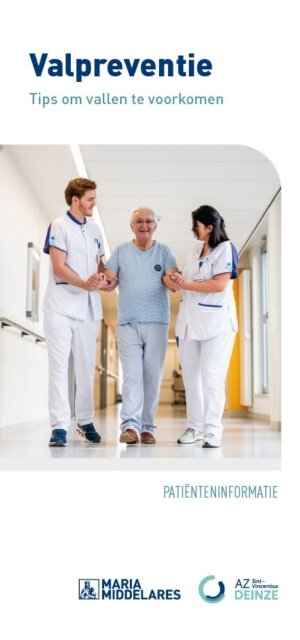Falls
Symptoms and causes
Symptoms and causesWhat are they?
Falls are a common problem among the elderly and are often a reason for hospitalisation. About 1 in 3 over-65s living at home fall at least once a year. Among elderly people living in residential care homes, this figure easily rises to 2 out of 3. The risk of falling increases with age and with cognitive problems, such as dementia.
Causes
The causes of falls are diverse and are sometimes due to acombination of several factors. The most common causes are balance disorders, a drop in blood pressure (orthostatic hypotension), loss of muscle strength, poor mobility, tripping, improper or excessive use of medication (polypharmacy), dementia, fear of falling or a collision.
Consequences
Falls can have far-reaching consequences for the elderly person on physical, mental, social and emotional levels. Physical injuries from a fall can range from a bruise or abrasion to an open wound, bruise, bone fracture or head injury. In addition to these physical consequences, elderly people often find falls to be traumatic experience. They may develop a fear of falling to various degrees. This fear of falling can become so great that the person starts avoiding certain activities or even moving around. The stop engaging in social activities and become less mobile. Due to decreased physical activity, the body becomes less conditioned. A person’s muscles become weaker and the balance and fitness also deteriorate. Once the elderly person does start moving again, he or she is actually more at risk of falling again. After all, the person’s body is no longer used to moving. Developing a high or excessive (i.e. crippling) fear of falling can thus set in motion a vicious cycle, which results in a higher risk of falling. Besides possible hospitalisation, falls can also be a reason for elderly people (and/or family members) to move to an assisted living facility.
Diagnosis and treatment
Diagnosis and treatmentHow can falls be prevented?
The good news is that falls can often be prevented. Key measures to prevent falls include:
- wearing well-fitting, closed footwear
- avoiding abrupt movements after prolonged sitting or lying down, straighten up calmly and get up only after any dizziness has subsided
- avoid walking after taking sedatives or sleep aids
- always wear your glasses
- ensure adequate lighting in rooms and corridors turn on a light at night when you need to go to the toilet
- make sure the floors are free of obstacles (e.g. cables, carpets, mats and loose objects) avoid slippery or wet floors
- place items you use regularly within easy reach
- provide handles near the toilet and bathtub place a non-slip mat in the bath or shower Our occupational therapists can help you with tips and advice on home adaptations or aids for preventing falls. Ask about them!
- Keep moving. This will keep your muscles strong and train your balance. Our physical therapists can help you with specific fall-prevention exercise programmes. They can also give you tips on exercises you can do at home. Ask about them!
More information can be found on the fall prevention website or in the informational leaflets below.
Treatment centres and specialisations
Treatment centres and specialisations
Latest publication date: 02/08/2024
Supervising author: Dr. Desimpelaere Patrick
Something wrong or unclear on this page? Report it.
Supervising author: Dr. Desimpelaere Patrick







